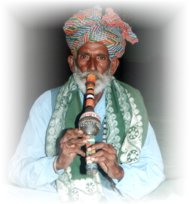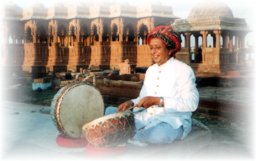|
Though Morchang is a nice and tiny rhythmic musical instrument, yet it has not been so popular in Kutch so far. There are a few artists of it. Among them, Mr. Samat Sajan Pathan, Mr. Musa Gulam Jat is masters over it. Mr. Samat Pathan not only plays Morchang, he can sing folklore too at the same time while playing it. It is very difficult to play and singing consecutively. It should be noted that late Mr. Isakbhai could get the sound of Morchang without use of instrument. He was moving his finger while blowing. 
To play Morchang is not so easy. It hurts tongue, lips and lungs. It requires constant riaz to get sweet rhythmic sound. There are very few artists of Morchang in Kutch at this time. The author is also an artist of Morchang. He has played the Morchang in many cultural functions held in various parts of India. He participated in Folk Instrument Music Festival, Panaji-Goa organized by the Government of India. He played Morchang and Bhorrindo in that function. His recitation broadcast over All India Radio, Bhuj, telecast over Doordarshan, Ahmedabad occasionally. He also played it in Surabhi – a cultural magazine serial shown over Doordarshan – 1 New Delhi with a view to highlight Kutchi folk music tradition.
Murli:
Murli consists of two parts: the upper one called ‘Murli' and the lower one called per (foot). The upper part is made out of a variety of gourd, which is dried and hollowed for the purpose. It serves as the main sound chamber. The lower part of per consists of two reed pipes, joined into a double container form, which are inserted into the main sound chamber from below and adjusted determinedly by means of a thick wax band. Wind is blown by mouth into the Murli at the upper end and, to produce music, the sound is regulated by adjusting finger tips.

Of the two reed pipes, the left one (to the player) with eight central holes, is the main device for spelling out the melodies. The right one, with two holes at the end, is called Madi Sur ji nali (lit. ‘Pipe of the female tune') that is the pipe for improvising the auxiliary supporting tune.
According to their music regulating functions, the eight holes in the left pipe are called: 1. Shahid, 2. Wichu, 3. Ti-Tari, 4. Murhala, 5. Sur, 6. Baach, 7. Dhukkar and 8. Cheech. The seventh one is meant for adjusting the tal or rhythm, and serves the purpose of tabla and thus called dhukkar.
Murli is also known as Pungi and been and it has been used mainly by the snake charmers all over Indian sub-continent. It was developed in Sind as ‘an instrument of music' and that's why it is called “Murli”.
The traditional music styles of Murli are the following ones: (i) Dhammal, two kinds: Gogay- Poti and Sadhaeen-Poti, and (ii) Lahro, two kinds: Naro or Narr and Gajishahi Lahro. Now- a-days, both classical and popular folk style melodies can be played on Murli.
Nagara:
Nagara (sing. Nagaro) is the Sindhized form of the Arabic Naqqarah. The chamber of the Sindhi Nagaro consists of a sizeable semi-circular baked carton bowl, on the open side of which a specially treated skin is fastened around the rim with strong strings which are tightened over the back side of the Nagara in a four-sided figure design form.

A pair of Nagara constitutes the music band, of which the one meant for low pitch beats is called Nar (the Male) and the other for the high pitch beats the zeel. The Nar is also called bam which is Persian word, which zeel is the Sindhized form of Persian zir, short wooden sticks somewhat twisting outward at the upper end, called danka, are used for beating the Nagara, The Nagara player squats in between the pair of Nagara with a drum stick in each-hand. To play the different rhythm structures he must be able to use a combination of the front, side, back-hand and the cross strokes with great dexterousness. The pitch of the beats is changed by means of hand or soft strokes on different parts of each drum of the pair.
The Nagara is a big half spherical and narrow bottomed drum which is made of wrapped up copper, brass or expanse iron. It varies in size, both in diameter and depth of its body. The large Nagara is a permanent contest in many temples. The drum, head is covered with thick animal hide which is firmly laced to the body by leather straps of thick ropes with or without the studs of metal. At the bottom end, a small hole is made through which water is poured into the bowl to lower the tension of the drum head.
It is played either by a single or a pair of sticks and it produces deep, crashing and ample sound. The quality of tone depends on quality of the skin used and diameter of the drum head. It has no device for changing the tension of skin-heads except for the use of paste or application of water on the parchment or exposing the drum-head to controlled heat. The larger ones have fixed indefinite pitch and limited rhythmic range when played individually.
|